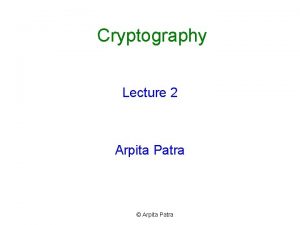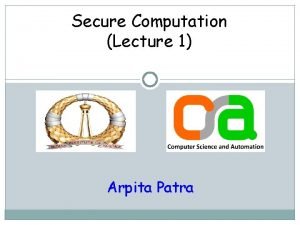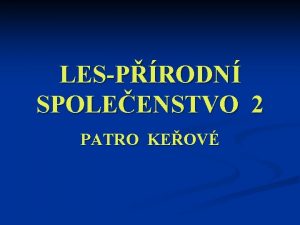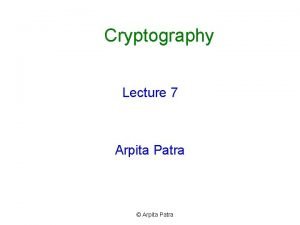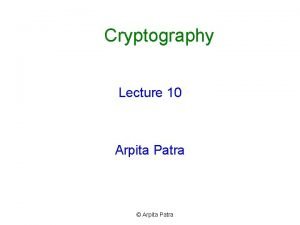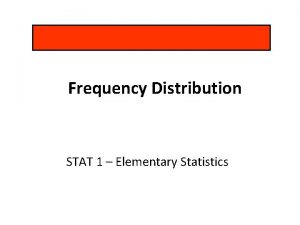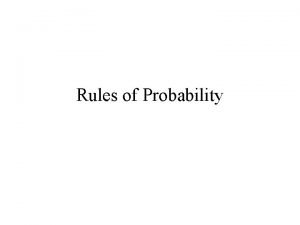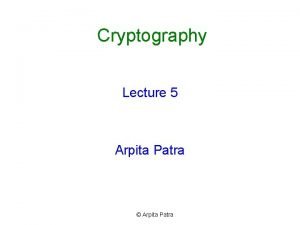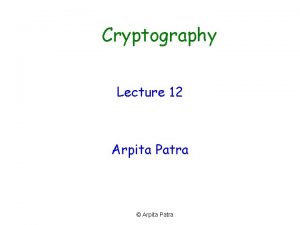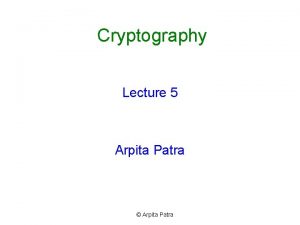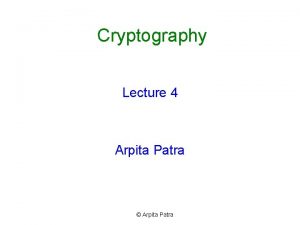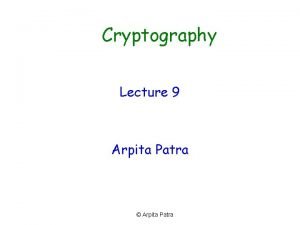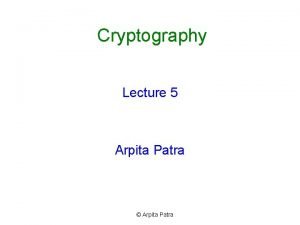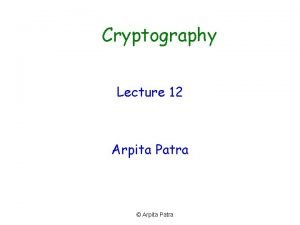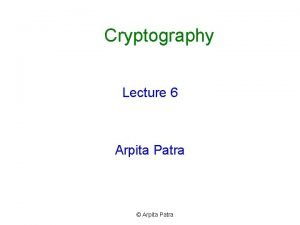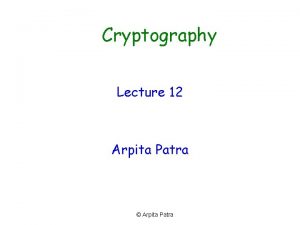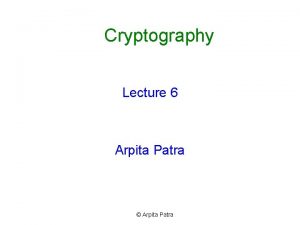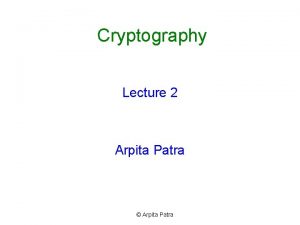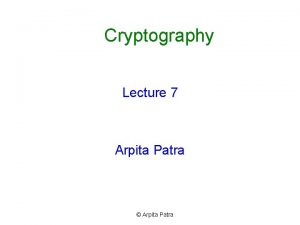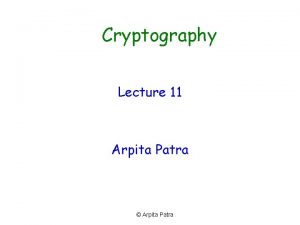Cryptography Lecture 3 Arpita Patra Arpita Patra Recall




















- Slides: 20

Cryptography Lecture 3 Arpita Patra © Arpita Patra

Recall >> Study of SKE in ‘modern’ way o o Definition (Perfect Security: unbounded adversary + no additional leakage) Construction (OTP / Vernam Cipher) Proof Drawbacks (on key length and key reusability) “You should never re-use a one-time pad. It’s like toilet paper; if you re-use it, things get messy. ” Michael Rabin

Today’s Goal - Inherent drawback on key space - More definitions of Perfect Security and their equivalence o Captures different intuition for the same goal o Some definition will be more handy to prove and disprove if a SKE is perfectly -secure o Will further confirm that OTP is optimal in many other ways - Summarizing & Concluding Perfect Security - Find alternative relaxed security notion than perfect security o Introduction to Computational Security > Formulate a formal definition (threat + break model) > Identify assumptions needed and build a construction > Prove security of the construction relative to the definition and assumption

Key Space Must be As Large as the Message Space Theorem: In any perfectly-secure encryption scheme | K | | M | Proof: OTP is optimal key Let c be a ciphertext with Pr(C = c) > 0 length-wise M(c) : = { m | m = Deck (c) for some k} for instance uniformand key Assume the set of all possible decrypted messages distribution overof. Mc(any dist. bility-wise usa Where every message occurs Assume | K | < | M | | M(c) | <|M| with non-zero prob is fine) m M s. t. m M(c) Pr [M = m | C = c] = 0 No perfect Security! Pr [M = m] Show the other limitation is inevitable too!

Perfectly-secure Encryption : Equivalent Definition Perfectly-secure Encryption (Shannon’s Definition): Pr[M = m | C = c] = Pr [M = m] , m M, c C Interpretation : probability of knowing a plain-text remains the same before and after seeing the cipher-text The equivalence holds for any probability distribution over M Perfectly-secure Encryption (Alternate Definition): Pr[C = c | M = m 0] = Pr [C = c | M = m 1], m 0, m 1 M, c C Interpretation : probability distribution of cipher-text is independent of plain-text

Shannon’s Theorem: A scheme (Gen, Enc, Dec) with | K | = | M | = | C | is perfectly secure if and only if (i) Every key k is chosen with probability 1/ | K | by Gen. (ii) For every m in M and every c in C, there is a unique key k s. t. Enck(m) = c. Why the assumption | K | = | M | = | C | ? m 1 c 1 m 2 m 3 m 4 k c 2 c 3

Shannon’s Theorem: A scheme (Gen, Enc, Dec) with | K | = | M | = | C | is perfectly secure if and only if (i) Every key k is chosen with probability 1/ | K | by Gen. (ii) For every m in M and every c in C, there is a unique key k s. t. Enck(m) = c. Proof: (Part 1) To prove Pr[M = m | C = c] = Pr[M = m] For arbitrary c and m, Pr[C = c | M = m] = Pr[K = k] Pr[C = c] = Σ Pr[C = c | M = m] Pr[M = m] = 1/| K | (irrespective of p. d. over M) m in M = 1/| K | Σ Pr[M = m] = 1/| K | m in M Pr[M = m | C = c] = Pr[C = c | M = m ] Pr[M = m] Pr[C = c] (Bayes' Theorem) = Pr[M = m]

Shannon’s Theorem: A scheme (Gen, Enc, Dec) with | K | = | M | = | C | is perfectly secure if and only if (i) Every key k is chosen with probability 1/ | K | by Gen. (ii) For every m in M and every c in C, there is a unique key k s. t. Enck(m) = c. Proof: (Part 2) To prove (i) and (ii) as above Let M = {m 1, m 2, …. . } and c is a ciphertext that occurs with non-zero probability for some message Let Ki is the set of all keys that maps mi to c i. e. Enck (mi) = c iff k belongs to Ki We assume that Pr[C = c | M = m] > 0, for some m For arbitrary c, mi and mj, Pr[C = c | M = mi] Assume the same k maps both mi and mj to c Correctness fails!! = Pr[C = c | M = mj]

Shannon’s Theorem: A scheme (Gen, Enc, Dec) with | K | = | M | = | C | is perfectly secure if and only if (i) Every key k is chosen with probability 1/ | K | by Gen. (ii) For every m in M and every c in C, there is a unique key k s. t. Enck(m) = c. Proof: (Part 2) To prove (i) and (ii) as above m 1 m 2 mn K 1 K 2 Kn |K|=|M| Pr[K = ki] = | Ki | = 1 Condition (ii) Pr[C = c | M = mi] = Pr[C = c | M = mj] = Pr[K = kj] Condition (i)

Shannon’s Theorem: A scheme (Gen, Enc, Dec) with | K | = | M | = | C | is perfectly secure if and only if (i) Every key k is chosen with probability 1/ | K | by Gen. (ii) For every m in M and every c in C, there is a unique key k s. t. Enck(m) = c. (i) k c e h c o t -Easy and (ii). ny a f o d e e n -No probability ke i l n u n o i t a l calcu ect f r e p l a n i g i or n o i t i n i f e d y t securi

Perfect Secrecy: Equivalent Definitions Definition I: For every probability dist over M Definition II: For every probability dist over M Pr[M = m | C = c] = Pr [M = m] m M, c C Pr[C = c | M = m 0] = Pr [C = c | M = m 1] m 0, m 1 M, c C Definition III: For every probability distribution over M (i) Every key k is chosen with probability 1/ | K | (ii) For every m in M and every c in C, there is a unique key k s. t. Enck(m) = c.

Perfect Secrecy as an Indistinguishability game - Formulated as a challenge-response game between adv. and a verifier = (Gen, Enc, Dec), M Hypothetical verifier Comp. unbounded m 0 , m 1 M (freedom to choose any pair) b {0, 1} c Enck(mb) b’ {0, 1} I can break (Guess about encrypted message) q Game output : Ø 1 if b = b’ Attacker won Ø 0 if b ≠ b’ Attacker lost k Gen

Perfect Secrecy as an Indistinguishability game Comp. unbounded = (Gen, Enc, Dec), M m 0 , m 1 M b {0, 1} c Enck(mb) b’ {0, 1} I can break Experiment : Priv. K k Gen coa A, q What does the above experiment model ? q Adversary should learn the underlying m {m 0, message m 1} from c only with probability ½ c Enc k Ø No better than guessing m k (I know that either m 0 or m 1 will be communicated with equal prob. ) q Perfect secrecy : adversary should not get “any advantage” by seeing c above

Perfect Secrecy as an Indistinguishability game Comp. unbounded = (Gen, Enc, Dec), M m 0 , m 1 M b {0, 1} c Enck(mb) b’ {0, 1} I can break Experiment : Priv. K k Gen coa A, q Experiment output : Ø 1 if b = b’ Attacker won (it found the underlying message) Perfect indistinguishability Ø 0 if b ≠ b’ Attacker lost (failed to find the underlying message) = (Gen, Enc, Dec) over M is perfectly-secure if for every attacker A coa Pr Priv. K A, = 1 = ½

Chalk & Talk I (for two): Equivalence of Definitions Definition I: For every probability dist over M Definition II: For every probability dist over M Pr[M = m | C = c] = Pr [M = m] m M, c C Pr[C = c | M = m 0] = Pr [C = c | M = m 1] m 0, m 1 M, c C Definition III: For every probability distribution over M (i) Every key k is chosen with probability 1/ | K | (ii) For every m in M and every c in C, there is a unique key k s. t. Enck(m) = c. Unbounded Powerful (Perfect Indistinguishability) b {0, 1} m 0, m 1 M c Enck(mb) b’ {0, 1} I can break Experiment : is perfectly-secure if for every adversary A k Priv. K Pr Gen coa A, Priv. K coa A, =1 = ½

Chalk & Talk II (for one) - Implementation of OTP for English text & Cryptanalysis of OTP when key is reused

Concluding Perfect Security CCA at the end t a h t r e b Remem to is an p y r c y a d of the nd we a e c CPA n ie c s ed out some info appligives mes the A ciphertext t scheabout Randomized c u r t s n o c to additional to the prior ed is nethat message f o h Unbounded Powerful t r i al B actichas r p s a h t information that the adv a h t COA tional / COA urdles in h e a h t T. u e p c Com relevan ecurity s t c e f r e p c Inherent Limitations: i h p chieving a a r Two g o gth of t n e p r t s e h Cry t utweighs o - Key Space as large as message space. ecurity y s t i t r c e u f r c e p e S - Keys can not be reused No point in studying perfect security by strengthening the adv by giving more capability in attacking a protocol, as the limitations will carry over. Unbounded Powerful Can we overcome the hurdles? Yes!! No break allowed Bounded Powerful / Polynomially Bounded Two relaxations Break is allowed but with ‘very small’ probability

Concluding Perfect Security - Have we put the last nail in the coffin of perfect security? By all means no! - We overlooked efficiently of perfectly-secure scheme among the hullaballoos of limitations! - It’s blazing fast compared to the computationally-secure protocols that we design - Efficiency is in fact hallmark of perfectly-secure schemes - Perfect security is interesting in multi-party setting Many problems in crypto involves more than two parties- MPC, E-election etc. In crypto, we live in the world of trade-offs…

Perfect Security vs. Computational Security Threat is Unbounded Powerful Threat is ‘Computationally Bounded’ No break allowed Break is allowed with ‘small’ probability A scheme is secure if Pr [M = m | C = c] = Pr [M = m] m, c A scheme is secure if any computationally bounded adversary succeeds in ‘breaking’ the scheme with at most ‘some very small probability’. Key as large as the message A small key will do Fresh key for every encryption Key reuse is permitted. Is it necessary to relax the threat and break to overcome the limitations? YES Absolutely!

 Recallcrypto. com
Recallcrypto. com Arpita patra iisc
Arpita patra iisc 01:640:244 lecture notes - lecture 15: plat, idah, farad
01:640:244 lecture notes - lecture 15: plat, idah, farad Patra lesa
Patra lesa Goutam patra
Goutam patra Rostlinná patra
Rostlinná patra Pragyapan patra nepal
Pragyapan patra nepal Era of quality at the akshaya patra foundation
Era of quality at the akshaya patra foundation Cipher patra
Cipher patra Cipher patra
Cipher patra Sudhakar patra
Sudhakar patra Akshaya patra donation online
Akshaya patra donation online Yamane formula for sample size
Yamane formula for sample size Fdt statistics
Fdt statistics Gos infant formula
Gos infant formula Beef recall
Beef recall Can hypnosis force people to act against their will
Can hypnosis force people to act against their will Recall the rules of probability
Recall the rules of probability Recall column
Recall column Difference between recognition and recall
Difference between recognition and recall Woodcock johnson test sample
Woodcock johnson test sample
